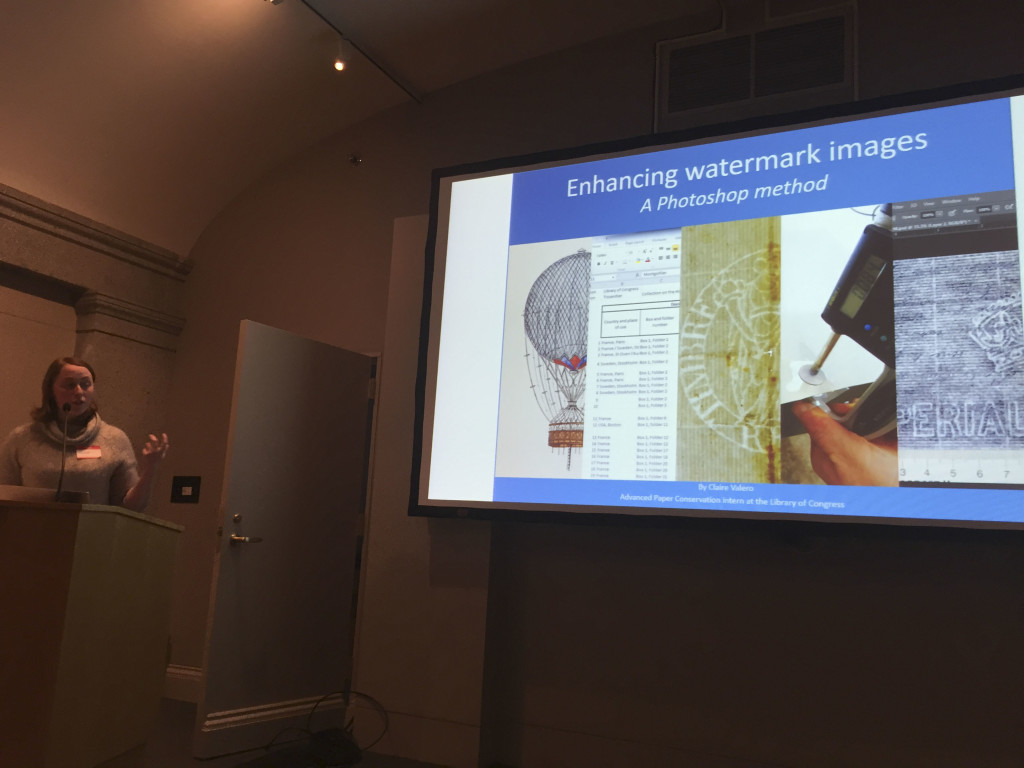Presenter: Claire Valero. WCG Intern talks, 5th April 2018 at the MacMillan Education Center, Smithsonian American Art Museum.

Claire talked about building the database of watermarks for the Tissandier Collection at the Library of Congress. She started by talking about the history of the Tissandier Collection. It was purchased by the Library of Congress in 1930 and contains approximately eight thousand items which were collected by Albert and Gaston Tissandier, famous balloonists and writers. The collection documents the early history of aeronautics with an emphasis on balloon flight in France and other European countries. One of the reasons the Tissandiers studied this collection was that it contained manuscripts from the Montgolfier brothers, Joseph and Etienne Montgolfier, who were pioneer developers of the hot-air balloon. Claire then talked briefly about the history of the invention of the first air-balloon.
The bulk of the Tissandier collection spans the years 1780 to 1910, a period ripe for study as the collection contains a mix of laid and wove papers, hand-made and machine-made. The aim of Claire’s project was to provide a comprehensive and complete database of watermarks in the collection, using a simple, cost effective and reproducible method of recording the designs legibly. Ultimately, these enhanced images will enable identification of provenance or dating.
She then elaborated on the three steps of building the database:
Step 1: Choose parameters and categories for the database. The “Bernstein – the Memory of Paper” watermark databases portal was created in 2009 by the International Association of Paper Historians in collaboration with 4 other European institutions to allow searches in different languages and simultaneous access to remote distributed databases. After reviewing all these databases available online and the international standards from the IPH, categories were chosen to provide a complete database. Claire’s project’s aim was to participate in the enlargement and improvement of watermarks databases already available.
Step 2: Choose suitable approaches to record watermarks. Three approaches are generally favored: tracing by hand, transmitted light photography and beta radiography. Precision, objectivity, simplicity, reproducibility and cost effectiveness were believed to be crucial. She then explained the disadvantages of the three approaches. At the Library of Congress, she used the transmitted light photography method, coupled with digital manipulations with Photoshop and found this method to be simple, quick and cheap. Generating digital data and allowing for future additional manipulations were also advantageous.
Step 3: Enhance the contrast between the dark areas of the writing and the transparency of the watermark that appears weak in comparison. She first tried to enhance the contrast with a filter, which didn’t yield the satisfactory results. Then she reversed her way of thinking; she first selected the darkest pixels in the image with the “Colour range” tool, erased this selection, and retouched this loss with a midtone selected from the image to blend in the area. Next she turned the contrast to the maximum and adjusted the level of contrast in the image by selecting the whitest and darkest pixel in the image.
Claire concluded by commenting on the advantages of this method, including its simplicity, reproducibility and accessibility, as well as its similarity to conservation practice in terms of reversibility. She also mentioned the drawbacks of this method when applying it to a huge surface covered by media or a very dark picture, as well as that the process can be very time consuming when dealing with a large collection.
Summarizer: Xiao Ma, Charles E. Culpeper Fellow in the Scientific Research Department at the National Gallery of Art